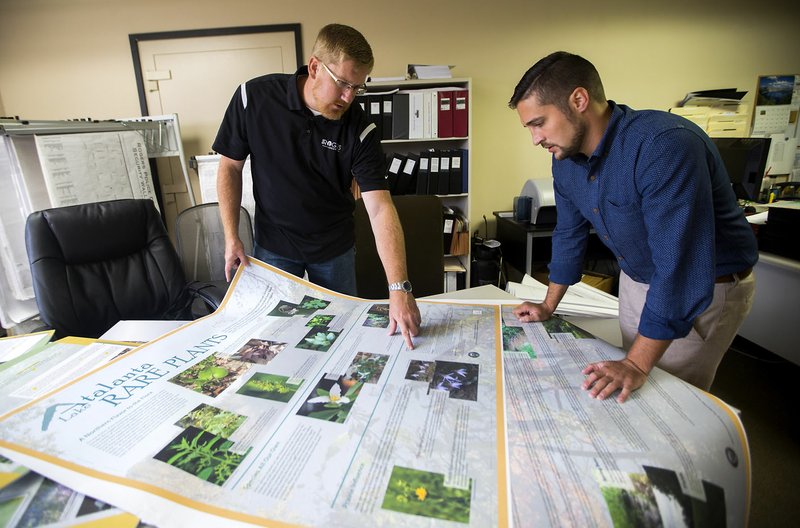ROGERS -- Educational signs help park visitors learn more about their environment, and the signage planned for Lake Atalanta Park got a special touch from area birders and regional plant experts.
"These signs are different than most," said David Hook, facilities development manager for the city. Hook said the Planning Department didn't follow typical guidelines in creating them. "We included more in-depth information and more photos with input from various groups, including the Rogers Historical Museum, the birding community, plant experts, schools and teachers."
Approximately five large signs, each 48 inches tall, and at least eight smaller signs are in the latter stages of mockups. Final corrections will be made this week so the signs can be installed before the park's reopening in October.
Of the large signs, one consists of a timeline for the park's history, and another exhibits a large map. Four others detail the plant and bird life in the rich and diverse environment surrounding Lake Atalanta.
A plant expert from the Arkansas Natural Heritage Commission conducted an inventory of plants in 2013 and 2014, before renovations to the park began. Information from that report was used for the educational signs about plants. It also directed renovations around rare plants to protect.
It also helped city employees know which species were harmful. Plants such as the tree of heaven; winter creeper, an evergreen vine; poison hemlock, found on stream banks; and oriental bittersweet were identified as invasive species that should be cut back.
"It mainly gave staff the opportunity to prioritize ongoing maintenance of areas to get rid of invasive species, do controlled burns" and such, Hook said. "We still have more to do, because that maintenance takes time and money, but it's ongoing."
A total of 608 plant species were reported in the Lake Atalanta area.
"That's a lot, a lot higher than a lot of other places would be," said Theo Witsell, a botanist for the Arkansas Natural Heritage Commission who conducted the survey. "It shows habitat diversity."
The 235-acre park can support so many types of plants because it has wetland, springs, forested hills, glades, rocky areas and grasslands, Witsell said. Of the hundreds of species found, nine plants are of concern for state conservation, including Ozark Trillium, Taper Tip Wild Ginger, Church's wild rye and White Rattlesnake-root.
Conservation for Ozark Trillium is especially dire, since it can only be found in the Ozarks and the Ouachita Mountains. Taper Tip Wild Ginger, found only in moist and cool ravines, is similarly rare and can only be seen in the Appalachian Mountains, the northern U.S. and the Ozarks. Church's wild rye grows in dry, rocky woodlands and glades.
It's that dichotomy of a place that has moist ravine areas and dry woodlands that sets Lake Atalanta apart, he said.
"The neat thing about it is that it's in this region of the Ozarks where there are dry prairie elements and open grassland, deep ravines with northern flora," Witsell said. "If you were out in the plains, you couldn't have that and the Northeast wouldn't have those elements. It's a crossroad of ecological regions."
Hook said the city used a nontraditional technique for the park signs by relying on a group of birders to supply the images of birds, some common and some rare, that regularly visit the area.
An online database where local birders record their sightings of bird species in the area -- eBird -- reports that 182 species live in the Lake Atalanta area.
"That's a lot of different species," said Ellen Turner, a professor of biology at Northwest Arkansas Community College and an instructor for Northwest Arkansas Master Naturalists. Turner, along with Northwest Arkansas Audubon, helped narrow the selection down to 10 species for the lake signs.
"Lake Atalanta is a unique ecological place," Turner said. "I'm amazed at the diversity there ... and it excites me that city employees want to understand what it takes to manage a park in a way to enhance flora and fauna."
The combination of having springs nearby and a lake that doesn't freeze in the winter creates a welcoming environment for many types of birds, Turner said. Springs have a more constant temperature year-round than mere streams, and "anytime you have water, you have insects and all the ingredients you need for animals to find food," Turner said.
Bald eagles, veery, osprey, Alder flycatchers and several migrant warblers are among the rare species that can be spotted around the lake.
Regional growth has caused a greater desire in Northwest Arkansas for spaces such as Lake Atalanta Park, Witsell said, and he said he imagines that will translate to residents taking care of their natural environments.
"There's a lot of interest in having areas with natural components of landscape protected," he said. "They're hungry for habitat-protected areas, that's clear. If they know more about natural habitats and species, they'll be more advocates for protecting them."
NW News on 08/22/2016
